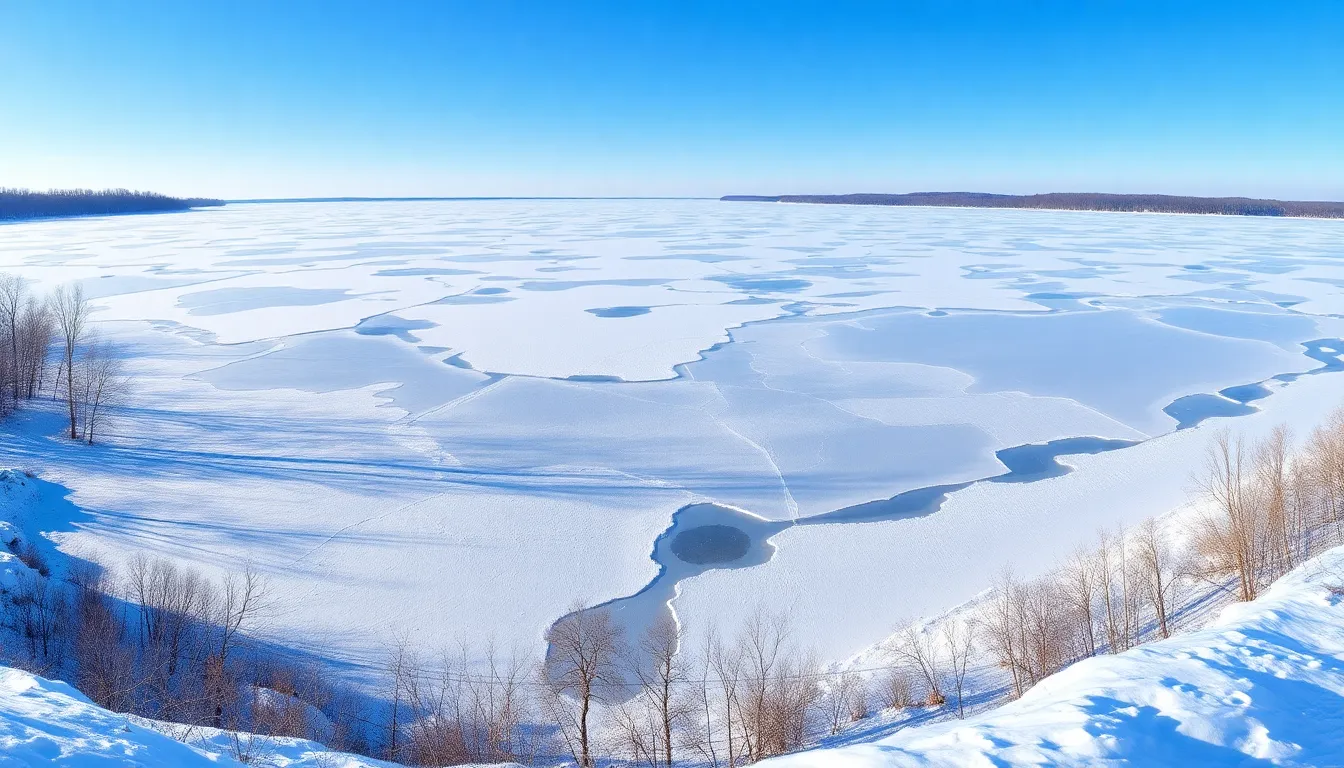Lake Erie’s ice cover is a topic that’s as captivating as it is slippery. One day, it’s a winter wonderland; the next, it’s a watery playground for adventurous anglers. Understanding the current ice conditions on Lake Erie isn’t just for the thrill-seekers; it’s vital for anyone interested in fishing, boating, or simply enjoying the stunning views.
With climate change throwing a curveball at traditional weather patterns, the ice cover can change faster than a squirrel on caffeine. So whether you’re planning a frosty fishing trip or just curious about the icy landscape, knowing today’s ice cover can save you from an unexpected plunge into the chilly waters. Let’s dive into what’s happening on Lake Erie today—because who wouldn’t want to be in the know about this frosty gem?
Table of Contents
ToggleOverview Of Lake Erie Ice Cover
Lake Erie ice cover plays a crucial role in the local ecosystem and recreational activities. The current ice cover extends across approximately 50% of the lake’s surface, showcasing a significant amount of frozen area despite fluctuating temperatures. This percentage reflects seasonal changes and various meteorological factors influencing ice formation.
Monitoring ice cover is vital for regional fishing activities. Anglers depend on safe ice thickness for winter fishing expeditions. Reports indicate that areas near the shore have reached ice thicknesses of 4 to 6 inches, suitable for fishing, while deeper regions exhibit thinner ice.
Weather patterns directly affect the ice situation. Cold snaps followed by warm fronts can lead to rapid melting or consolidation of ice. Historical data shows that significant variations in ice cover occur yearly, underscoring the unpredictable nature of climate conditions on Lake Erie.
Recreational boating requires up-to-date information on ice conditions. Boaters should check ice reports regularly as conditions can change within hours. The U.S. Coast Guard provides relevant safety guidelines, emphasizing the importance of understanding ice dynamics before venturing onto the lake.
Overall, the current state of Lake Erie ice cover remains a priority for local authorities. Tracking ice levels and assessing safety contribute to enhancing winter recreational experiences. Initiatives aimed at studying climate impacts on ice cover could further improve understanding and inform future adaptability.
Historical Context

Understanding the historical context of ice cover on Lake Erie provides insight into current conditions. Patterns of ice cover have fluctuated significantly over the years.
Ice Cover Patterns Over The Years
Ice cover patterns on Lake Erie have varied annually, influenced by winter temperatures and weather conditions. The late 1970s experienced some of the thickest ice cover, with annual averages exceeding 90%. Conversely, recent years show a trend of significantly reduced ice cover, frequently dropping to below 50%. Seasonal variations illustrate that drastic changes occur due to temperature shifts and precipitation levels, impacting aquatic life and recreational activities.
Significant Changes In Recent Decades
Recent decades exhibit notable changes in ice cover due to climate variations. The 2000s marked a decline in average ice cover, with instances of low records affecting winter activities. In 2014, a rebound occurred with near-record ice levels, yet subsequent years continued the trend of decline. Both warming temperatures and changes in weather patterns play crucial roles in these fluctuations. With each passing year, monitoring ice cover becomes increasingly vital for understanding its ecological impacts and for planning seasonal recreation.
Current Status Of Lake Erie Ice Cover Today
Current ice cover on Lake Erie reaches approximately 50% of its surface. This measurement varies rapidly due to fluctuating weather patterns and temperatures, making it essential for local activities like fishing and boating.
Measurement Methods Used
Remote sensing technology plays a vital role in measuring ice cover. Satellites equipped with thermal infrared sensors capture images and data. Research teams often utilize aerial surveys for detailed assessments. Ground observations help validate satellite data, enhancing accuracy. Data collected allows for timely updates on ice conditions, aiding both recreational and commercial activities.
Ice Coverage Statistics
Lake Erie currently exhibits about 50% ice cover, a significant drop from historical averages exceeding 90%. Areas near the shore present 4 to 6 inches of ice thickness, while deeper sections show thinner coverage. This year’s trends reflect a continuity of reduced ice, correlating with warming temperatures observed since the 2000s. Monitoring these statistics provides critical insights for local authorities and recreational planning.
Factors Influencing Ice Cover
Lake Erie’s ice cover fluctuates due to various environmental factors. Understanding these influences is essential for comprehending its impact on local activities and ecosystems.
Climate Change Impacts
Warming temperatures directly affect ice formation, leading to reduced coverage on Lake Erie. Recent data indicates that average ice cover often falls below 50%. The late 1970s presented thicker ice conditions, while recent decades show a marked decline. Enhanced precipitation patterns result from climate changes, further complicating ice stability. Analysis of past ice cover trends reveals significant variability linked to increasing temperatures, highlighting the urgency in monitoring these changes. Maintaining awareness of these factors helps residents and stakeholders plan for recreational activities sustainably.
Seasonal Weather Variations
Temperature fluctuations during winter vary the extent of ice cover significantly. Cold snaps bring quick ice formation, whereas warmer weather leads to early melting. Storm patterns can also contribute to ice thickness disparities. Historical weather data indicates that winters with consistent cold conditions foster thicker ice. Shifts in pressure systems often dictate the presence of warm fronts, contributing to this year’s ice conditions. Seasonal changes directly relate to safe conditions for both fishing and boating, making real-time ice information vital for those planning outdoor winter activities.
Implications Of Ice Cover Changes
Ice cover changes on Lake Erie carry significant implications for the environment and economy. Monitoring these shifts helps to understand their wide-ranging effects on local ecosystems and industries.
Ecosystem Effects
Reduced ice cover alters habitats for various species. Fish populations rely on stable ice conditions for spawning and feeding. Thinner or absent ice disrupts these processes, resulting in lower fish survival rates. Aquatic plants also suffer, as their growth depends on stable conditions provided by ice cover. Changes in predator-prey dynamics occur as warmer water temperatures shift species distributions. Biodiversity faces threats due to these fluctuations, impacting the lake’s overall health. Research highlights the importance of maintaining consistent ice cover for sustaining local wildlife.
Economic Considerations
Economic activities related to Lake Erie experience direct impacts from ice cover changes. The fishing industry relies heavily on safe ice conditions for ice fishing, and reduced ice can limit access to prime fishing spots. Retailers and local businesses depend on winter tourism, and less ice cover diminishes recreational opportunities such as ice skating and snowmobiling. The boating industry also feels the pressure, as early melting changes seasonal timelines. Monitoring ice conditions provides vital information for tourism planning and helps businesses prepare for fluctuating visitor patterns. Keeping track of these developments ensures proactive strategies for preserving economic stability in the region.
Understanding the current ice cover on Lake Erie is vital for both recreational activities and ecological health. With approximately 50% ice coverage today the situation remains dynamic and influenced by ongoing climate changes. Anglers and boaters must stay informed about varying ice conditions to ensure safety and enjoyment on the water.
The implications of these changes extend beyond personal recreation. They affect local economies and ecosystems alike. As the climate continues to evolve monitoring ice cover will be essential for adapting to these shifts. Staying updated on ice conditions not only enhances safety but also fosters a deeper appreciation for Lake Erie’s winter beauty.





